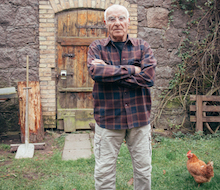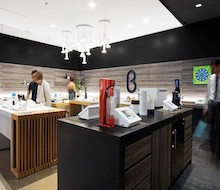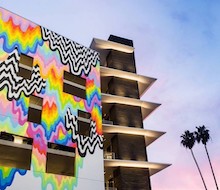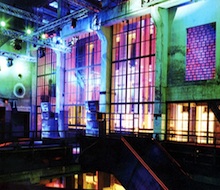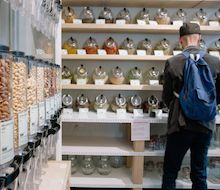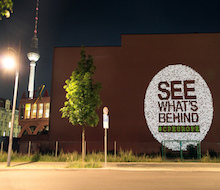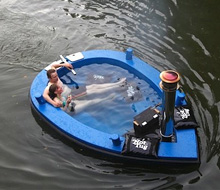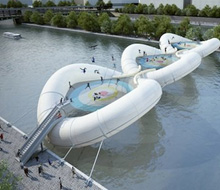For PSFK‘s Future of Retail 2018 report, I sat down with b8ta founder & CEO Vibhu Norby to discuss how retailers need to figure out a new business model to survive the retail armageddon
Online versus offline retail today is kind of like the e-book versus paper conundrum. It’s a no-brainer that physical retailers will never be able to beat e-commerce websites at convenience and supply chain efficiencies, just like how toting around 47 of your favorite Taschen coffee table books will never be as practical as carrying a Kindle. But people need to stop thinking of physical and digital retail as an ‘either/or’ scenario when it’s more of an ‘and.’
There will always be a need for physical stores, because there are countless things you can experience inside a store that you simply can’t by scrolling a website. You can’t touch, wear or truly discover a product with all of your senses. And in today’s world, where products are more tech-driven and more of a financial investment than ever, it’s never been more paramount for consumers to learn about and fully engage with a product.
So rather than convincing themselves that in order to beat Amazon, companies need to poach its customers, the future of retail will no longer depend entirely on sales, product margins and supply chain logistics, but on discovery and the customer experience. With this belief, Vibhu Norby founded software-powered retailer b8ta with Nicholas Mann, William Mintun and Phillip Raub in 2015, as a way to make physical retail accessible for all by selling manufacturers monthly subscriptions to display their products in b8ta stores.
With 79 stores now across the U.S., b8ta is essentially an Internet-of-Things showroom where customers can play with high-tech gadgets and ask trained staff questions about how they work. For PSFK’s Future of Retail 2018 report, I sat down with Vibhu to discuss how retailers need to figure out a business model where they can monetize real-life interaction with products instead of the sale itself.
PSFK: If retailers are going to survive in today’s world of commerce, they need a new business model. What do you envision this business model looking like?
Vibhu: I think the business model of multi-brand retailers who are in the business of wholesale is the one that is most broken and has been hurt the most by the Internet. The industry on the whole isn’t evolving very fast because retailers have not been able to convince shareholders that they should invest in things other than e-commerce and stop the leakage of sales to Amazon. To be honest, I literally can’t think of single thing that multi-brand retailers are doing well today.
Target’s CEO Brian Cornell once said that the Whole Foods acquisition validates what he has been saying all along: Physical stores still matter. What are the important trends shaping the future of physical stores, malls and offline retail?
The problem is that retailers have convinced themselves that in order to beat Amazon, they need to steal transactions from Amazon. Instead, they need to get better at selling the same things that Amazon sells or sell things that Amazon does not sell. Those should be their two strategies. We are way past a place where retailers can compete with Amazon for sales. They need to figure out how to work together with the Internet symbiotically.
The reason that physical retail still exists and will continue to exist forever is because the physical world itself has use cases around products and services that a screen cannot provide like a demonstration of a product, a trial, a smell, a feel or a taste. Retailers need to figure out how to be in the game of real-life interaction with products, and construct a business model where their suppliers can monetize that instead of the sale. That’s our belief.
We’re finally seeing retailers do it in limited trials. Our partnership with Macy’s and Lowe’s is one way that we’ve been able to help some multi-brand retailers think about a different business model. The difference in our thinking and the traditional retailer thinking is that they’ve always thought about the customer, but they’ve actually always been in the business of servicing brands and helping them bring their products to market and distribution.
They need to figure out how to win the next generation of brands who do not want to be in their stores and want to own their customer relationships online. They want to own their margins. They want to own their data about the people that are shopping in their stores. That’s the transition that they’ve had trouble figuring out.
Although they always phrase things from the customer side, like “Customers like to shop omnichannel,” ultimately, customers will shop wherever the products are that they’re interested in, and the brands must simply figure out a way to find those customers.
How can brands compete with retail behemoths like Amazon?
The business of discovery, the business of processing credit cards and the business of getting a product from one place to another are all different things, and there are companies that are really good at each one of those things. Facebook is really good at helping people discover products through their advertising network, whereas FedEx and Amazon are good at getting products from one place to another. Retailers need to figure out what business they want to be in.
I think that the multi-brand, department store-type retailers like Macy’s, Nordstrom, J.C. Penney and Whole Foods are fundamentally in the discovery business, whereas, a company like Walmart should be in the supply chain business. In that case, they better figure out the Internet, because if the customer knows what they want, they’re going to pick something that’s really convenient to them.
Now that the physical and digital worlds of retail are blending together, how can brands utilize technology to improve shopping experiences?
I often think about how we can better tie together the online behavior of a customer to the offline behavior and vice versa. When someone comes into your store and doesn’t buy the product, how do you know how much interest you actually generated in that customer and what it was worth? Did that customer buy the product later from somewhere else, or did they tell a friend about it who then purchased the product?
Tracking store traffic is sort of table stakes. In order to know how to allocate money to marketing efforts between online and offline or whether you’re actually winning new customers or getting repeat customers, you need to have a really solid understanding of what your customers are doing. I’m most interested in that technology because it’s really difficult to develop. There’s not a good off-the-shelf solution for being able to quantify the value of someone coming into the store and looking at products and engaging with them.
How you are you utilizing IoT technology and AI-powered analytics to transform physical locations into rich environments for capturing customer behaviors and activity, and translating that data into valuable insights?
At b8ta, we think about the store as an engagement vehicle. When we are bringing a brand into the space, they want to understand how many interested customers and demonstrations of products we’re actually providing them. It’s not useful on its own, but it’s useful in comparison to other places where you’re doing business.
Even the Herald Square store here has 90 cameras installed within it that are using machine vision and other technologies to quantify the shopper’s interaction with each product. We’re not using the technology to shift the customer experience at all. It’s purely to help the brands understand what’s going on and why they should be here versus somewhere else, because they have lots of places they can spend money and put their product out.
The other benefit is that when you can see how efficiently customers are finding the product and then that is converting into an engagement, a demonstration or a sale and you can see that across multiple stores, you can start to test new strategies very quickly without having to redo the store or the product.
You can test different price points, marketing messages and training programs with the staff, see how they work and then iterate on that to improve those conversion rates. That’s something that’s easy online, but hard to do offline if you don’t adjust the way that the business works and the way that the store is constructed.
How are you redesigning the consumer’s point of sale experience—including purchase, delivery and return— from a static checkout counter to a modular network of mobile and on-demand services that increase shopper convenience and satisfaction while improving backend efficiency?
We’re never going to be the most convenient way to buy a product because we’re in the stores business. Any time you have to get someone out of their seat to do something today, it’s going to be inconvenient. I think we’ve tried our best in our own way to innovate the fundamental experience of learning about the product. That’s why when you see a product in one of our stores, it’s out of the box. It’s ready for demo. We’ve built technology in the back-end that is ensuring that all of our b8ta testers have the application installed on their devices so they can provide demos.
Then there’s a tablet next to it detailing all the information that the customer can learn about on their own if there’s not an associate there to help them or if they don’t want help. The tablet’s always in sync with the latest information the company has because it can be updated in real time.
In that sense, again, we’re trying to make sure that we’re offering something in-store that you would normally only get online. The worst experience that customers can have in a physical store is finding something they are really excited about buying it and then going home and seeing it available on the brand’s website for less.
We use technology to make sure that that doesn’t happen. You’d be surprised, but in some other stores, this is a big problem. Without a dynamic pricing solution like we’ve built that features the price that can be updated versus just stickers, it’s pretty difficult to do. Our associates also have a mobile app that we built for them that allows them to talk to the brands to make sure they have the best information on the product or to ask them a question that a customer might have that they don’t have an answer to. That’s pretty unique.
If you walked into Best Buy today and you asked a question that the associate didn’t know the answer to, there would be no way for them to get the answer other than to Google it, which the customer can do themselves. We enable constant learning through this app. On top of that, a lot of the brands actually come and train our staff directly. In fact, when you sign up with us for the first time as a maker, you’re required to train our people yourself. We like to hear how they explain their own product.
How does b8ta approach programming its retail locations with a constant overhaul of brands, products and experiences to keep its stores and spaces feeling fresh and exciting?
We want people to visit the store when they see something that they’re interested in learning more about, so they come in and get a hands-on demo of that product. Six months might pass and they might not be interested in any of the other things that we have. But they see an ad on Instagram for the new Sonos speaker. They need a place to come and try it. They know that the last time they came they had a good experience so they want to come back.
The brands that we work with are constantly producing new products, so the assortment is fresh in that sense. We also work with so many brands today that we sort of inherited the American entrepreneurship rates. There are always people starting new companies every year. There are always companies that are going out of business. When a new product launches, they’re looking for space. They come in and take space with us. There’s always that happening.
You will never come in month to month and see the same assortment, but it’s not because we’re curating it. It’s because that’s how the economy is today. It’s moving so fast that you can actually see the life cycle of companies in a short time frame.
18% of the companies we worked with in the last two years have gone out of business. Small businesses fail in the first year at a rate of 20%. After four years, it’s 80%. You don’t usually see that rapid change happening because the retailers are not working with small companies. We love working with small companies.
What do you think have been the key ingredients to success for those brands who have succeeded in your stores?
You have to make a good product that resonates with people. I think the most important attribute of a good product is that it’s something that people want to tell other people about. It needs to be a good story. I think the best companies are very good at allocating marketing dollars. They really understand when they put a dollar into their marketing machine how much is coming out of that and over what time period.
How are you developing solutions that provide customers with the ability to pay across as many technology platforms as possible—for example, in-store, in-app, online and in AR and VR?
We support as many as are feasible. We don’t have an application. We couldn’t think of a good reason to make an iPhone app or an Android app. We don’t even accept cash because it’s not worth the effort. Walmart is 25% cash. We tested cash when we first launched. It was 5% of our transactions. But in exchange for that 5%, you have to have a safe deposit box and all kinds of procedures. You need to have someone take it out, count it, go to the bank, deposit it. We thought, “That’s a lot of work for 5%.”
I actually think that most of the point-of-sale technology today was not created with the plethora of business models that direct-to-consumer brands are employing today. It was made for this simple select item, swipe card and move on. But a lot of the companies that we work with, when you buy from their website for example, it’s not add item, put credit card information and you’re done. It’s select item, select package, add a subscription plan, add accessories. The idea of transacting is just more complex than what most of these systems support today.
We have spent a lot of time thinking about how to make sure the checkout experience reflects the business models of the brands.
How are you designing log-in experiences within physical environments that trigger tailored service, recommendations and in-store activations, while simultaneously syncing customer experiences both on and offline?
I think it’s something we would like to do, but it’s relatively hard to do in a way that’s not creepy and disruptive. You never want to ask someone who walks into a store to log in before they browse. You don’t want to interrupt that experience. I do think that you will see this happen a lot in other categories. To walk into the Amazon grocery store, you need to be essentially logged in.
Personally, I don’t want to walk into the store and have to sign in. But, if I already had the app and was therefore already logged in, I’d be interested. It’s effectively the same problem that advertising tech companies have today in trying to compete with Google and Facebook for ad dollars, because every person in the world is logged into their services. You have to be at such a large scale for that to be true most of the time that it’s difficult for a startup to compete.
I would want an advertising network like Google or Facebook to provide the infrastructure. They know identity the best. You’re always logged into these platforms. I would never build that myself as a small company.
What’s on the horizon for b8ta in 2018 and beyond?
We’ve grown really fast and have been lucky to do so. We’ve been thrown a lot of opportunities to work with other retailers and real estate folks. Next year, we’re going to do a couple of extremely special-source flagships. We’re going to continue to work with retail partners. The business is really good for us and it’s really great for the retailer and the brands.
We’ve got some new ways of thinking about retail as a service that I think will blow people’s minds when we roll them out in the retail industry. It’s all based on our progress and learnings from rolling out 79 stores this year. We’ve learned a lot and we’ve really got something to say to the industry.
For more information on how companies can transform their stores into experience centers that extend their supply chain and digital commerce platforms, check out PSFK’s Future of Retail 2018.







